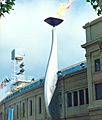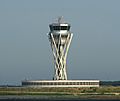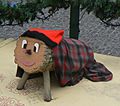Catalonia facts for kids
{{Infobox settlement | name = Catalonia | official_name =
| native_name =
| settlement_type = Autonomous community | image_flag = Flag of Catalonia.svg | flag_size = 125px | flag_alt = Senyera | image_shield = Coat of Arms of Catalonia.svg | shield_size = 65px | motto =
| anthem = Els Segadors (Catalan)
"The Reapers"
| image_map = Cataluna in Spain (plus Canarias).svg | map_alt = Map of Catalonia in Spain | map_caption = Location of Catalonia (red) in Spain | image_map1 = E.U-Catalonia.png | mapsize1 = 270px | map_alt1 = Catalonia in Spain and Europe
| map_caption1 =
– on the European continent (green & dark grey)
– in Spain (green)
| coordinates = 41°49′N 1°28′E / 41.817°N 1.467°E | coor_pinpoint = | subdivision_type = Country | subdivision_name = Spain | subdivision_type1 = Status | subdivision_name1 = Autonomous community (styled as nationality) | established_title = Formation | established_date = 988 (Catalan Counties)
1137 ([[Crown of Aragon|UnionCatalan constitutions)}}
1469 (Union of Castile and Aragon under Catholic Monarchs)
1716 (Nueva Planta decrees) | established_title1 = Statute of Autonomy | established_date1 = 9 September 1932
18 September 1979
9 August 2006 (current version) | established_title2 = | established_date2 = | seat_type = Capital
and largest city | seat = Barcelona
41°23′N 2°11′E / 41.383°N 2.183°E | parts_type = Provinces | parts_style = para | p1 = Barcelona | government_footnotes = | government_type = Devolved government in a constitutional monarchy
| governing_body = Generalitat of Catalonia | leader_party = | leader_title = President | leader_name = Quim Torra (JuntsxCat) | leader_title1 = Legislature | leader_name1 = Parliament | area_footnotes = | area_total_km2 = 32108 | area_land_km2 = | area_water_km2 = | area_water_percent = | area_rank = 6th in Spain | population_total = 7,522,596 | population_as_of = 2016 | population_footnotes = | population_density_km2 = 234 | population_rank = 2nd in Spain (16%) | population_demonyms = Catalan or Catalonian
català, -ana (ca)
catalán, -ana (es)
catalan, -a (oc) | population_note = | demographics_type1 = GDP | demographics1_footnotes = (nominal; 2017) | demographics1_title1 = Total | demographics_type2 = GDP | demographics2_footnotes = (PPP; 2017) | demographics2_title1 = Total | demographics2_info1 = $343 billion | blank3_name_sec2 = HDI (2017) | blank3_info_sec2 = 0.905
very high · 4th | timezone1_DST = CEST | utc_offset1_DST = +2 | postal_code_type = | postal_code = | area_code = +34 93 (Barcelona area)
+34 97 (rest of Catalonia) | area_code_type = Area code | iso_code = ES-CT | blank_name_sec1 = Official languages | blank_info_sec1 = Catalan, Occitan (Aranese), Spanish,
Catalan Sign Language (also recognised) | blank1_name_sec1 = Patron saints | blank1_info_sec1 = Saint George (Sant Jordi), Virgin of Montserrat
| website = gencat.cat | footnotes = | p2 = Girona | p3 = Lleida | p4 = Tarragona | leader_title3 = Congress of Deputies | leader_name3 = 48 Deputies (of 350) | leader_title4 = Senate | leader_name4 = 24 Senators (of 265) | unemployment_rate = | demographics1_info1 = €224 billion | demographics1_title2 = Per capita | demographics1_info2 = €30,100 | demographics2_title2 = Per capita | demographics2_info2 = $46,024 | timezone = CET | utc_offset = +1 }} Catalonia (Spanish: Cataluña; Catalan: Catalunya; Occitan: Catalonha) is a special part of Spain. It is located in the northeast of the country. Catalonia shares a border with France in the north.
It has four main areas called provinces: Barcelona, Tarragona, Girona (Spanish: Gerona), and Lleida (Spanish: Lérida). More than 7 million people live here. Catalonia has three official languages: Catalan, Spanish, and Occitan. Occitan is spoken in a small northern area called Val d'Aran, near France.
The capital city of Catalonia is Barcelona. It hosted the Olympic Games in 1992. Barcelona is on the Mediterranean coast. It is a very popular place for tourists in the summer.
Catalans have their own special powers within Spain. They have their own local government and police. They also have some control over their community. In 2005, the Catalan Parliament called Catalonia a 'nation' in a special law. This law was approved in 2006.
Catalonia is one of the richest regions in Southern Europe. This is mainly because industries, especially textile factories, started here earlier. The region also gets more rain than Southern Spain. This means it is greener and has different kinds of crops. Northern Catalonia is also cooler than the rest of Spain.
On October 27, 2017, Catalonia declared independence from Spain after a vote. However, other countries around the world did not recognize this declaration.
Contents
Catalonia's History: A Quick Look
Catalonia has a long and interesting history. It was first formed from several small areas called Catalan counties in 988. Later, in 1137, it joined with the Crown of Aragon. This was a powerful kingdom in the past.
Becoming Part of Spain
In 1469, Catalonia became part of a larger union with Castile and Aragon. This happened under the Catholic Monarchs of Spain. In 1716, new laws called the Nueva Planta decrees changed how Catalonia was governed.
Modern Autonomy
Catalonia gained more self-rule in the 20th century. The first Statute of Autonomy was approved in 1932. After a period without it, a new statute was approved in 1979. The most recent version was approved in 2006. This law gives Catalonia its special powers within Spain.
Geography and Nature in Catalonia
Catalonia has many different landscapes. It has mountains, rivers, and a long coastline.
Mountains and Rivers
The Pyrenees mountains are in the north of Catalonia. They form a natural border with France. The highest peak in Catalonia is Pica d'Estats. Many rivers flow through Catalonia, like the Ebro River.
The Coastline
Catalonia has a beautiful Mediterranean coastline. It includes famous areas like the Costa Brava and Costa Dorada. These coasts are known for their beaches and clear waters.
Wildlife and Plants
Catalonia is home to various animals and plants. In the mountains, you might find chamois and marmots. The forests have oaks and pines. The region also has unique animals like the Montseny brook newt.
Catalan Culture and Traditions
Catalonia has a very rich and unique culture. It has its own language, music, and traditions.
Languages Spoken
As mentioned, Catalan is an official language. It is spoken by most people in Catalonia. Spanish is also an official language. Occitan (specifically the Aranese variety) is spoken in the Val d'Aran.
Festivals and Celebrations
Catalans love their festivals. One famous tradition is building castells, which are human towers. Another popular dance is the Sardana. During Christmas, children look forward to Tió de Nadal, a special log that "poops" presents.
Food and Cuisine
Catalan food is delicious! A simple but popular dish is Pa amb tomàquet (bread with tomato). Seafood is also very common along the coast.
Economy and Industry
Catalonia is one of the most important economic regions in Spain.
Main Industries
Historically, the textile industry was very important. Today, Catalonia has a strong economy in many areas. These include manufacturing, chemicals, and food production.
Tourism
Tourism is a huge part of Catalonia's economy. Millions of visitors come each year to enjoy the beaches, cities, and mountains. Barcelona is a major tourist destination.
Transportation
Catalonia has a modern transport system. It includes major airports like Barcelona El Prat Airport, a large port in Barcelona, and a good network of roads and high-speed trains.
Sports in Catalonia
Sports are very popular in Catalonia.
Football
FC Barcelona is one of the most famous football clubs in the world. Their home stadium, Camp Nou, is huge. Many famous players and coaches, like Pep Guardiola, come from Catalonia.
Other Sports
Catalonia also hosts important motor racing events at the Circuit de Barcelona-Catalunya. Basketball and handball are also popular sports in the region.
Images for kids
-
The Roca dels Moros contain paintings protected as part of the Rock art of the Iberian Mediterranean Basin, a World Heritage Site
-
Iberian fortress Els Vilars in Arbeca
-
A Roman aqueduct in Tarragona
-
Origins of the blason of the County of Barcelona, by Claudi Lorenzale
-
Petronilla of Aragon and Ramon Berenguer IV, Count of Barcelona, dynastic union of the Crown of Aragon
-
The Principality of Catalonia (1608)
-
Corpus de Sang (7 June 1640), one of the main events of the Reaper's War. Painted in 1910
-
Third Siege of Girona (1809), Peninsular War against Napoleon
-
Demonstration after the Tragic Week, 1909
-
The Olympic flame in the Olympic Stadium Lluís Companys of Barcelona during the 1992 Summer Olympics
-
Catalan president, Carles Puigdemont, addresses to the crowd following the unilateral declaration of independence on 27 October
-
Mountain of Montserrat and the monastery
-
Montseny brook newt (Calotriton arnoldi), endemic to the Montseny Massif
-
Tossa de Mar, Costa Brava
-
Peach fields in Aitona
-
Industrial park in Castellbisbal
-
Factories, La Pobla de Mafumet, Tarragona
-
Eix Macià, Sabadell
-
The Medieval church of Sant Climent de Taüll, located at the foothills of the Pyrenees, in the province of Lleida
-
Sagrada Família, Barcelona
-
Gegants i capgrossos during the festa major of La Seu d'Urgell
-
Pa amb tomàquet (bread with tomato)
-
Olympic Park of Montjuïc, Barcelona. At the centre, the Olympic Stadium Lluís Companys
-
Camp Nou, home of FC Barcelona
See also
 In Spanish: Cataluña para niños
In Spanish: Cataluña para niños












































